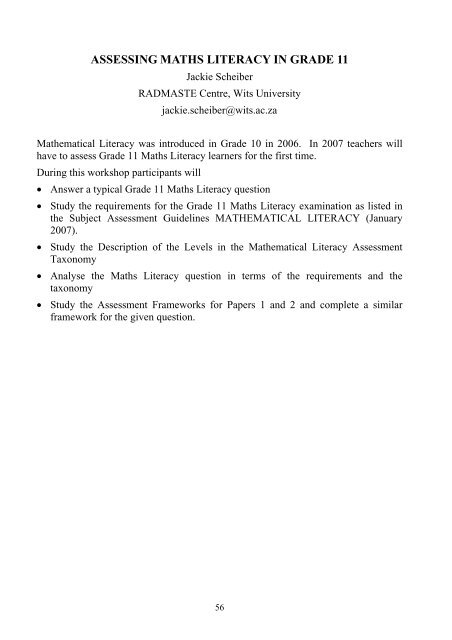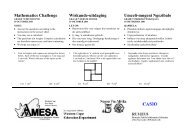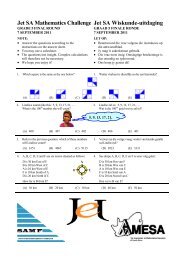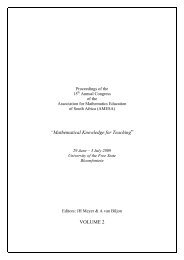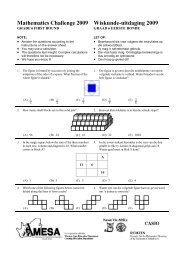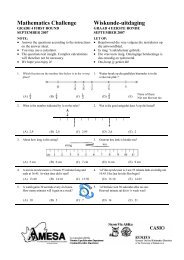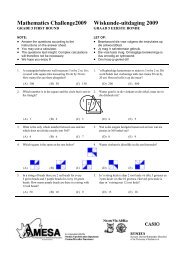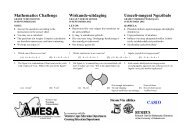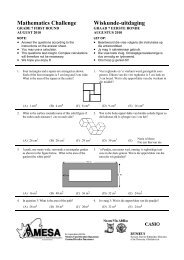Assessing Maths Literacy in grade 11 - AMESA
Assessing Maths Literacy in grade 11 - AMESA
Assessing Maths Literacy in grade 11 - AMESA
Create successful ePaper yourself
Turn your PDF publications into a flip-book with our unique Google optimized e-Paper software.
ASSESSING MATHS LITERACY IN GRADE <strong>11</strong>Jackie ScheiberRADMASTE Centre, Wits Universityjackie.scheiber@wits.ac.zaMathematical <strong>Literacy</strong> was <strong>in</strong>troduced <strong>in</strong> Grade 10 <strong>in</strong> 2006. In 2007 teachers willhave to assess Grade <strong>11</strong> <strong>Maths</strong> <strong>Literacy</strong> learners for the first time.Dur<strong>in</strong>g this workshop participants will• Answer a typical Grade <strong>11</strong> <strong>Maths</strong> <strong>Literacy</strong> question• Study the requirements for the Grade <strong>11</strong> <strong>Maths</strong> <strong>Literacy</strong> exam<strong>in</strong>ation as listed <strong>in</strong>the Subject Assessment Guidel<strong>in</strong>es MATHEMATICAL LITERACY (January2007).• Study the Description of the Levels <strong>in</strong> the Mathematical <strong>Literacy</strong> AssessmentTaxonomy• Analyse the <strong>Maths</strong> <strong>Literacy</strong> question <strong>in</strong> terms of the requirements and thetaxonomy• Study the Assessment Frameworks for Papers 1 and 2 and complete a similarframework for the given question.56
A TYPICAL GRADE <strong>11</strong> MATHS LITERACY QUESTIONQUESTION 1Mrs Phumzile owns a taxi bus<strong>in</strong>ess. The table below shows a list of MrsPhumzile's <strong>in</strong>come and expenditure for her bus<strong>in</strong>ess, for the month of February2007.INCOME EXPENDITUREPetrol R 1 065,70Wash<strong>in</strong>g of taxi R 60,00Servic<strong>in</strong>g of taxi ( oil change, spark plugs etR 546,09cetera)Fares paid by taxi commuters R7 842,00Insurance for the taxi (<strong>in</strong> case of an accident) R 305, 45Taxi-driver salary R 3 500,00Taxi association fee R 200,001.1 Determ<strong>in</strong>e, for February 2007:1.1.1 The total <strong>in</strong>come1.1.2 The total expenditure1.2 Did Mrs Phumzile’s taxi bus<strong>in</strong>ess make a profit or a loss for the monthof February?1.3 Calculate the profit or loss for this month(1)(2)(1)(2)1.4 Hence determ<strong>in</strong>e the profit marg<strong>in</strong> for the monthIncome − ExpensesUse the formula: Profit Marg<strong>in</strong> =Expenses× 100% (3)1.5 Mandla works as a taxi driver for Mrs Phumzile. His basic salary isR35,00 per hour. On Monday 18 February he worked from 06:00 to15:30 and had 1 hour off for lunch.1.5.1 How many hours did he work on that day?1.5.2 How much money did he earn on that day?Mrs Phumzile asks Mandla to transport passengers to a wedd<strong>in</strong>g 170km away. Mandla drives the taxi at an average speed of 90 km/h. Howmany hours will the journey take? (Use the formula: Distance = Speedx Time to calculate your answer.) Write your answer correct to twodecimal places.(2)(2)(4)[17]57
The requirements for the <strong>grade</strong> <strong>11</strong> mathematics literacy exam<strong>in</strong>ation as listed <strong>in</strong> thesubject assessment guidel<strong>in</strong>es mathematical literacy (January 2007).Accord<strong>in</strong>g to the Subject Assessment Guidel<strong>in</strong>es, the follow<strong>in</strong>g the time allocationsand number of papers is recommended for the f<strong>in</strong>al exam<strong>in</strong>ations for Grades 10, <strong>11</strong>and 12:GRADE 10 – one 3-hour paper of 150 marksGRADE <strong>11</strong> – two 2 ½ hour papers of 100 marks eachGRADE 12 – two 3-hour papers of 150 marksAccord<strong>in</strong>g to the Subject Assessment Guidel<strong>in</strong>es, an exam<strong>in</strong>ation should• Give equal weight<strong>in</strong>g to the four Learn<strong>in</strong>g Outcomes and should attempt toexam<strong>in</strong>e all of the Assessment Standards determ<strong>in</strong>ed for the <strong>grade</strong>• Consist of questions which all focus on a context• Consist of questions which <strong>in</strong>tegrate Assessment Standards from more than oneLearn<strong>in</strong>g Outcome• Be differentiated accord<strong>in</strong>g to the Mathematics <strong>Literacy</strong> taxonomy with thefollow<strong>in</strong>g proportion of marks allocated to each of the levels:o 30% of the marks at the know<strong>in</strong>g levelo 30% of the marks at the apply<strong>in</strong>g rout<strong>in</strong>e procedures <strong>in</strong> a variety of contexts levelo 20% of the marks at the apply<strong>in</strong>g multi-step procedures <strong>in</strong> a variety of contextslevelo 20% of the marks at the reason<strong>in</strong>g and reflect<strong>in</strong>g level.TABLE 1 – REQUIREMENTS FOR GRADE <strong>11</strong>LEVEL 1 LEVEL 2 LEVEL 3 LEVEL 4(30%) (30%) (20%) (20%)Know<strong>in</strong>g Apply<strong>in</strong>g rout<strong>in</strong>e Apply<strong>in</strong>g multistepprocedures reflect<strong>in</strong>gReason<strong>in</strong>g andprocedures <strong>in</strong>familiar contexts <strong>in</strong> a variety ofcontextsLO125%LO225%LO325%PAPER 1(2 ½ hours - 100 marks)Paper 1 is <strong>in</strong>tended to be abasic know<strong>in</strong>g and rout<strong>in</strong>eapplication paperConsists of between 5 and8 shorter questionsPaper 2(2 ½ hours – 100 marks)Paper 2 is <strong>in</strong>tended to be an applicationsand reason<strong>in</strong>g and reflect<strong>in</strong>g paperConsists of between 4 and 6 longerquestions.These questions will require more58
LO425%Questions focus on acontext60% on Level 1 and 40%on Level 2<strong>in</strong>terpretation and application of the<strong>in</strong>formation providedQuestions focus on a context20% on Level 2, 40% on Level 3 and40% on Level 4TABLE 2 – DESCRIPTION OF THE LEVELS IN THE MATHEMATICALLITERACY ASSESSMENT TAXONOMYLEVEL 1 (30%) LEVEL 2 (30%) LEVEL 3 (20%) LEVEL 4 (20%)Know<strong>in</strong>g• Calculate us<strong>in</strong>gthe basicoperations,<strong>in</strong>clud<strong>in</strong>g:-Algorithms for +,–, x and ÷-Appropriateround<strong>in</strong>g ofnumbers- Estimation- Calculat<strong>in</strong>g apercentage of agiven amount- measurement• Know and useappropriatevocabulary such asequation, formula,bar graph, piechart, Cartesianplane, table ofvalues, mean,median and mode• Know and useformulae such asthe area of aApply<strong>in</strong>g Rout<strong>in</strong>eProcedures InFamiliar Contextsc) Performswell-knownprocedures <strong>in</strong>familiar contexts.All the <strong>in</strong>formationrequired to solvethe problem isimmediatelyavailable to thestudentd) Solvesequations bymeans of trial anderror or algebraicprocessese) Draw datagraphs forprovided dataf) Drawalgebraic graphsfor given equationsg) Measuredimensions (e.g.length, weight andtime) us<strong>in</strong>gappropriateApply<strong>in</strong>g multi-stepprocedures <strong>in</strong> avariety of contextsh) Solveproblems us<strong>in</strong>gwell-knownprocedures. Thisrequiredprocedure is,however, notimmediatelyobvious from theway the problemis posed. Learnerswill have todecide on themost appropriateprocedure to solvethe solution to thequestion and mayhave to performone or moreprelim<strong>in</strong>arycalculationsbeforedeterm<strong>in</strong><strong>in</strong>g asolutioni) Select themost appropriateReason<strong>in</strong>g andreflect<strong>in</strong>gk) Pose and answerquestions aboutwhat mathematicsthey require tosolve a problemand then to selectand use thatmathematicalcontent.k) Interpret thesolution theydeterm<strong>in</strong>e to aproblem <strong>in</strong> thecontext of theproblem andwhere necessaryto adjust themathematicalsolution to makesense <strong>in</strong> thecontextl) Critique solutionsto problems andstatements aboutsituations madeby others59
ectangle, atriangle and acircle where eachof the requireddimensions isreadily availableRead <strong>in</strong>formationdirectly from atable (e.g. the timea particular busdeparts from theterm<strong>in</strong>al)measur<strong>in</strong>g<strong>in</strong>strumentssensitive to levelsof accuracydata from options<strong>in</strong> a table ofvalues to solve aproblemj) Decide onthe best way torepresent data tocreate a particularimpressionm) Generalizepatterns observed<strong>in</strong> situations,make predictionsbased on thesepatterns and/orother evidenceand determ<strong>in</strong>econditions thatwill lead todesired outcomes60
34the schoolbuild<strong>in</strong>gGlobalwarm<strong>in</strong>gCrimeStatistics2.1.2 3 3 32.1.3 2 2 22.2.1 3 3 32.2.2 4 2 2 42.3.1 1 1 12.3.2 5 5 52.3.3a 1 1 12.3.3b 2 2 23,1 2 2 23,2 2 2 4 43.3.1 4 1 5 53.3.2a 2 2 23.3.2b 2 2 23.3.3a 2 2 23.3.3b 2 2 23.3.4 2 2 24,1 2 2 24,2 3 3 34.3.1 2 2 24.3.2 4 4 427 21 30 22 22 39 39 100 1002<strong>11</strong>163


